Staking is an integral part of the Polkadot network, contributing to its security and decentralization. By staking DOT tokens, holders can earn rewards while supporting the network’s functionality. This article serves as a comprehensive guide to staking DOT tokens on Polkadot, exploring different staking options, how to select validators, and how to maximize staking rewards.
What is Staking?
Staking in blockchain networks, particularly those using Proof-of-Stake (PoS) consensus mechanisms, involves locking up a certain amount of cryptocurrency to participate in the network’s operations, such as validating transactions and securing the network. In return, participants receive rewards, usually in the form of additional tokens. Unlike Proof-of-Work (PoW) systems, which rely on energy-intensive mining, PoS systems require participants to lock up their tokens, making them more energy-efficient and accessible.
Proof-of-Stake (PoS) and Polkadot’s Nominated Proof-of-Stake (NPoS)
Polkadot uses a variant of PoS known as Nominated Proof-of-Stake (NPoS). In NPoS, token holders can either become validators or nominators. Validators are responsible for adding new blocks to the blockchain and validating transactions, while nominators support validators by staking their tokens in favor of specific validators. This system is designed to enhance network security and ensure that validators act in the best interest of the network.
Getting Started with Polkadot Staking
Choosing a Wallet
Before you begin staking, you need to store your DOT tokens in a secure wallet. Polkadot supports a variety of wallets, including:
- Nova Wallet: A mobile based wallet with staking and governance features.
- Polkadot-JS: The official web-based wallet with comprehensive staking features.
- SubWallet and Talisman Wallet: Browser extensions that provide easy access to staking.
- Ledger: A hardware wallet that offers enhanced security for your DOT tokens.
These wallets are listed on the official Polkadot website and are considered secure and user-friendly.
The Polkadot Staking Dashboard
Polkadot has introduced a new Staking Dashboard, simplifying the staking process. This dashboard is compatible with Ledger devices and does not require any browser extensions or third-party wallets. The dashboard provides an intuitive interface to manage your staking activities, including selecting validators, monitoring rewards, and managing nomination pools.
Staking Options on Polkadot
Direct Staking
Direct staking involves selecting validators and locking your DOT tokens directly on the Polkadot network. This method requires a minimum of 250 DOT to submit an intention to nominate, but the actual minimum amount needed to earn rewards can vary based on network conditions.
Nomination Pools
If you have fewer than the minimum amount required for direct staking, you can still participate in staking through nomination pools. These pools allow users to stake as little as 1 DOT and earn rewards proportionally. Nomination pools are an excellent option for those with smaller holdings who still want to participate in network security and earn rewards.
How to Stake DOT Tokens
Step 1: Locking Tokens (Bonding)
The first step in staking is to bond your DOT tokens, which involves locking them on the network. This process can be done through the Polkadot-JS UI, the Staking Dashboard, or a supported wallet. Once bonded, your tokens will be locked for a minimum period (28 days on Polkadot) and will earn staking rewards.
Step 2: Selecting Validators
Choosing the right validators is crucial to maximize your staking rewards and minimize risks. Polkadot allows you to nominate up to 16 validators. The network automatically allocates your bonded tokens to the selected validators based on an algorithm that optimizes for security and fairness.
Criteria for Selecting Validators
- Era Points: Validators earn era points for performing tasks on the network. Those with higher era points are generally more active and reliable.
- Self-Stake: Validators with a higher self-stake have more “skin in the game,” making them less likely to act maliciously.
- Total Stake: Validators with a balanced total stake (not too high, not too low) tend to offer better rewards.
- Commission: Validators charge a commission on rewards. Lower commissions mean higher returns for nominators, but a small commission ensures validators are incentivized to maintain high performance.
- Identity and History: Validators with a verified on-chain identity and a clean history (no slashes) are generally more trustworthy.
Step 3: Monitoring and Managing Your Staking
Staking on Polkadot is not a “set and forget” operation. It’s important to regularly monitor the performance of your validators and make adjustments if necessary. Validators can change their commission rates or performance over time, and some may be slashed for misbehavior. Regularly checking your staking dashboard ensures that your stake is always working optimally.
Maximizing Staking Rewards
To maximize your staking rewards, consider the following strategies:
Diversify Your Validator Selection
By nominating a diverse set of validators, you reduce the risk of all your tokens being impacted by a single validator’s underperformance or slashing. Polkadot’s system automatically distributes your stake across multiple validators, optimizing for security and reward potential.
Participate in Nomination Pools
If you’re staking a small amount of DOT, joining a nomination pool can help you earn rewards that would be difficult to achieve through direct staking. Pools aggregate the stakes of multiple users, allowing them to act as a single large nominator.
Reinvest Rewards
Reinvesting (or compounding) your rewards can significantly increase your staking returns over time. You can choose to automatically bond your rewards or manually reinvest them after claiming.
Staking Rewards and Risks
How Rewards Are Distributed
Staking rewards on Polkadot are distributed per era (approximately 24 hours on Polkadot). These rewards are shared among validators and their nominators based on the validator’s performance during the era. Validators receive rewards for producing blocks and participating in the consensus process, and they share these rewards with their nominators after deducting their commission.
Slashing Risks
Slashing is a mechanism designed to penalize validators (and their nominators) who act maliciously or fail to perform their duties. The severity of the penalty depends on the nature of the offense, ranging from minor fines to the complete loss of staked tokens. To minimize the risk of slashing, carefully select validators with a good track record and high self-stake.
Unbonding Period
When you decide to stop staking, your tokens will go through an unbonding period of 28 days on Polkadot. During this time, your tokens will not earn rewards and cannot be transferred or used for other purposes. This period serves as a security measure, allowing the network to identify and penalize any malicious behavior before tokens are released.
Stash Account and Staking Proxy
To enhance security, Polkadot allows you to use two separate accounts: a stash account and a staking proxy. The stash account holds the bonded tokens, while the staking proxy manages staking operations like nominating validators and claiming rewards. This setup reduces the risk of your bonded tokens being compromised, as the stash account’s private keys can be kept offline.
Advanced Staking Features
Fast Unstake
Polkadot offers a “Fast Unstake” feature, allowing users to unbond their DOT tokens immediately if they haven’t backed any active validator in the last 28 days. This feature is particularly useful for users who accidentally bonded their tokens or if their nominated validators were never active.
Chilling
Chilling is the process of stepping back from nominating or validating without unbonding your tokens. This can be done to avoid slashing during network issues or if you want to take a break from staking.
Nomination Pools Administration
Nomination pools are managed by a set of roles, including the depositor, nominator, bouncer, and root. These roles handle pool administration, such as selecting validators, managing pool states, and setting commission rates.
Conclusion
Staking DOT tokens on Polkadot is a rewarding way to contribute to the network’s security while earning passive income. Whether you choose to stake directly or through nomination pools, understanding the staking process, selecting reliable validators, and actively managing your stake are key to maximizing your rewards. By following this comprehensive guide, you can confidently navigate the staking landscape on Polkadot and make informed decisions that align with your investment goals.








